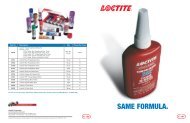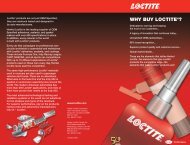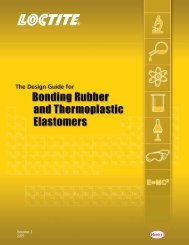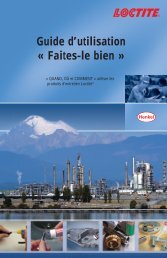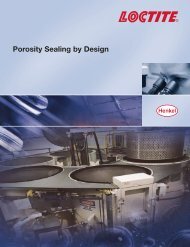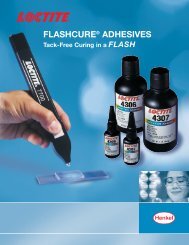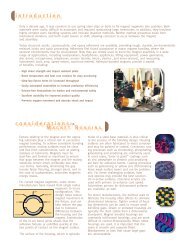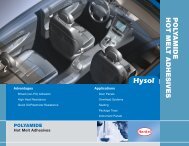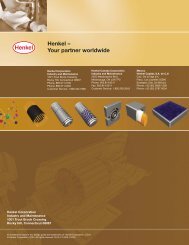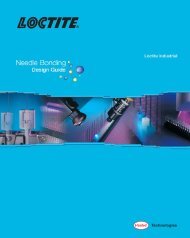Volume 4 - Loctite.ph
Volume 4 - Loctite.ph
Volume 4 - Loctite.ph
Create successful ePaper yourself
Turn your PDF publications into a flip-book with our unique Google optimized e-Paper software.
Silicone AdhesivesGeneral DescriptionSilicone adhesives are typically supplied as one-part systems that rangein viscosity from self-leveling liquids to non-slumping pastes. They cureto soft thermoset elastomers with excellent property retention over awide temperature range.Silicones have good adhesion to many substrates, but are limited intheir utility as structural adhesives by their low cohesive strength.Silicone adhesives are typically cured via reaction with ambienthumidity, although formulations are also available which can be curedby heat, mixing of two components, or exposure to ultraviolet light.Since the cure of moisture-curing silicones is dependent on moisturediffusing through the silicone matrix, the cure rate is strongly affectedby the ambient relative humidity and the maximum depth of cure islimited to 0.375 to 0.500". At 50% RH, moisture cure silicones will cureto a tack-free surface in 5 to 60 minutes, depending on the type used.Complete cure through thick sections of silicone can take up to72 hours. It should be noted that adhesive strength may continue todevelop for 1 to 2 weeks after the silicone has been applied. This occursbecause the reaction between the reactive groups on the siliconepolymer and the reactive groups on the substrate surface is slower thanthe crosslinking reaction of the silicone groups with themselves.Moisture curing silicones are categorized by the by-product given offas they react with moisture. For example, acetoxy cure silicones giveoff acetic acid. Alkoxy cure silicones give off alcohols (typicallymethanol or ethanol), and oxime curing silicones evolve methyl ethylketoxime. Acetoxy cure silicones are known for their ability to curerapidly and develop good adhesion to many substrates. Their largestlimitation is the potential for the by-product acetic acid to promotecorrosion. Alkoxy cure silicones, on the other hand, do not have thislimitation because the alcohol by-products are noncorrosive. Thismakes them well suited for electronic and medical applications whereacetic acid could be a problem. Unfortunately, alkoxy cure siliconestypically have lower adhesion and take longer to cure than acetoxycure silicones.intensity, they will form a tack-free surface and cure to a polymer withup to 80% of its ultimate <strong>ph</strong>ysical strength in less than a minute.Initial adhesion can be good, but because ultimate bond strength isdependent on the moisture cure portion of the silicone, full bondstrength can take 1 to 2 weeks to develop. Silicones with a secondaryacetoxy cure show good bond strength while those with a secondaryalkoxy cure are lower.ChemistrySilicone formulations are available which can be cured throughmoisture, heat, mixing two components, and exposure to ultravioletlight. The silicones used for adhesives are typically the one-partmoisture curing and UV curing silicones. All silicones have a chemicalbackbone made up of silicone to oxygen bonds, known as siloxanebonds. It is the high energy of this bond that gives silicones theirunique high temperature performance properties.Advantages• One-part systems available• Solvent-free• Room temperature cure• Excellent adhesion to many substrates• Extremely flexible• UV curing and 2-part formulations availableDisadvantages• Low cohesive strength• Moisture cure systems have limited depth of cure• Swelled by non-polar solventsOxime cure silicones offer cure speeds and adhesion that rival, and insome cases surpass, that of acetoxy cure silicones. In addition, theoxime they evolve will not corrode ferric substrates, although it canstain copper or brass. Consequently, oxime silicones have foundwidespread use in automotive gasketing applications. The chieflimitation of all moisture curing silicones is the difficulty associatedwith accelerating the cure rate. This concern was addressed throughthe development of UV cure silicones. Ultraviolet light curing siliconesgenerally also have a secondary moisture cure mechanism to insurethat any silicone which is not irradiated with ultraviolet light will stillcure. Upon exposure to ultraviolet light of the proper wavelength andThe <strong>Loctite</strong> ® Design Guide for Bonding Plastics, <strong>Volume</strong> 4 11



